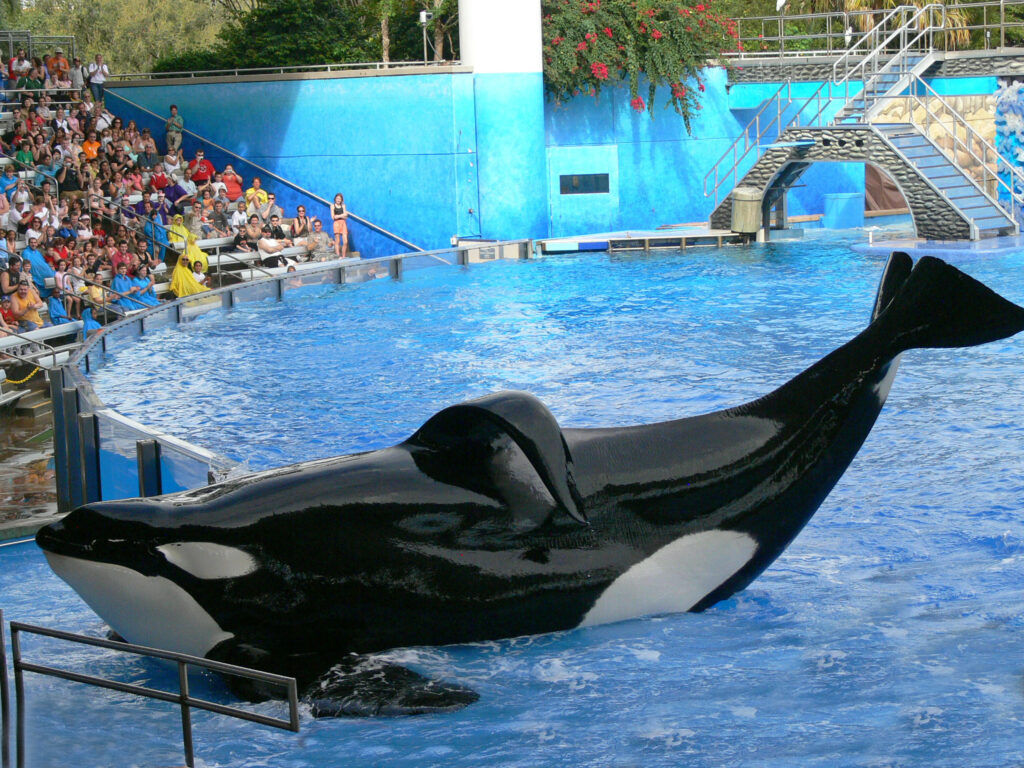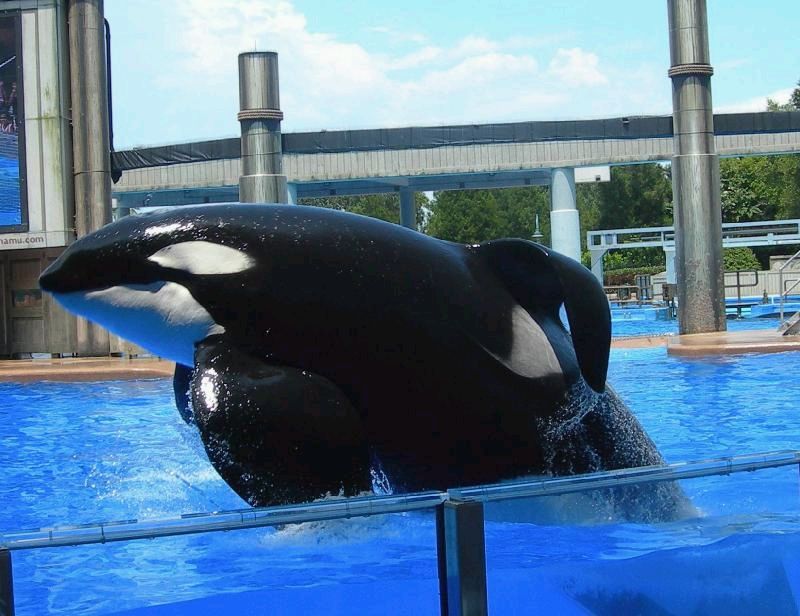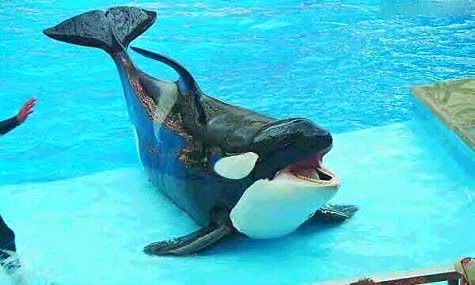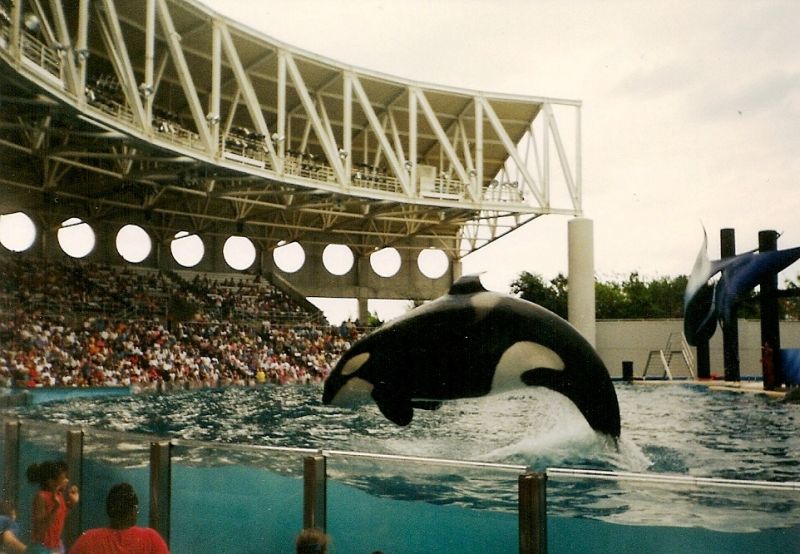Reason 21
“Yes, yeah it was the large whale, Tilikum, the male is the one that went after her and the other two just kind of circled around, but he was definitely the instigator.”… In the 1991 interview of the sister that recently played on Nightline, she says that a whale “pulled her under.” She did not identify which whale. She did not state that it was the “large whale Tilikum,” or state that it was the “male.”
Nadine Kallen is the woman who said “Yes, yeah it was the large whale, Tilikum, the male is the one that went after her and the other two just kind of circled around, but he was definitely the instigator.” I assume SeaWorld is referring to Kallen’s sister, Corinne Cowell, when stating “In the 1991 interview of the sister”. If they are, then the “evidence” they have for suggesting this statement is fabricated is inapplicable to Kallen. What Cowell said in her interview is completely separate to what Kallen said in Blackfish. They are different people and are not responsible for what each other say. Cowell did not specify a whale in the Nightline video and she did not specify a whale in Blackfish, so what she said during her interview on Nightline is completely irrelevant.</p style=”padding-left:50px;”>
Determination: Invalid / Debunked
Reason 22
Huxter: “My understanding of the situation is that Tilikum and others would not be used in shows, they would not be performance animals.”… This is not accurate, and appears to a mis-statement concerning the permits issued to bring Tilikum and the other Sealand of the Pacific whales into the United States…. The final permit ultimately obtained for Tilikum and the other Sealand whales was for the public display of all three animals.
Huxter’s statement is not a mis-statement. The permit SeaWorld obtained was for the whales to be displayed, not necessarily to perform (as you can see from the photos, all three whales performed at SeaWorld following their transfer). Putting animals on display and making animals perform are very different things. A difference Huxter clearly recognised. Huxter’s statement is not inaccurate or misleading, SeaWorld’s response, however, definitely is.</p style=”padding-left:50px;”>
Determination: Invalid / Debunked
__________________________________________________________________________________________________________________________________________________________________________________________________________________________________
Evidence:
Link 1: “On November 7, 1991, Sea World submitted an application to the National Marine Fisheries Service (“NMFS”), Department of Commerce, for a permit to import three killer whales, two females and one male, from Sealand of the Pacific for purposes of public display and captive propagation.” – Excerpt from a letter sent to the Icelandic Minister of Fisheries written by one of SeaWorld’s notorious executives, Brad Andrews. __________________________________________________________________________________________________________________________________________________________________________________________________________________________________
Reason 23
“And to this day, there’s no record of an orca doing any harm to any human in the wild.” This is false. There are documented instances of killer whales attacking humans in the wild.
It’s fair to critique this statement. Garrett worded this terribly. Point is, no human being has ever been killed by an orca in the wild despite millennia of encounters. In contrast, within a 20-year-period, 4 people have lost their lives to captive orcas.</p style=”padding-left:50px;”>
Determination: Agree
__________________________________________________________________________________________________________________________________________________________________________________________________________________________________
Evidence:
Link 1: https://inherentlywild.co.uk/aggressive-incidents/
Link 2: https://inherentlywild.co.uk/orcas-vs-humans/
__________________________________________________________________________________________________________________________________________________________________________________________________________________________________
Reason 24
“[t]he adult offspring never leave their mother’s side.”… The Film offers no scientific basis for this statement, SeaWorld is aware of none, and the statement defies logic.
Extensive research suggests adult male offspring of populations in the Pacific Northwest will live alongside their mothers for their entire lives, spending up to 70 percent of their time within one body length of their mother until the day she dies, and only leaving her to breed. I must admit this is another example of poor wording on Garrett’s part as the word “never” doesn’t leave room for an exemption for breeding.</p style=”padding-left:50px;”>
Determination: Agree & Invalid / Debunked
__________________________________________________________________________________________________________________________________________________________________________________________________________________________________
Evidence:
Link 1: https://www.youtube.com/watch?v=OmMv9t_hW8k&feature=youtu.be
__________________________________________________________________________________________________________________________________________________________________________________________________________________________________
Reason 25
Garret: “they have lifespans very similar to human life spans. The females can live to about 100, maybe more – males to about 50 or 60″ …There is no scientific support for this assertion.
AND
Reason 41
Garrett: “We knew by 1980, after half a dozen years of the research, that they live the equivalent to human life spans.” This is false. There is no scientific evidence to support Garrett’s assertion. The most recent study on life expectancy of southern resident killer whales is that females live on average between 30 and 46 years and males 19 to 31 years

If you very quickly research what the average human lifespan is, you’ll most likely find out it’s calculated as 79 years old. According to NOAA, an orca’s lifespan is upwards of 60-90 years. For the sake of making this more precise, a mean average of 75 years can be calculated. 75 years and 79 years are similar. Garrett is not incorrect to state so. SeaWorld’s claim that “there is no scientific evidence to support [this] assertion” is a blatant lie. Both Garett’s claim and NOAA’s information are consistent with figures within the Encyclopaedia of Marine Mammals.
I also find it quite laughable that SeaWorld have quoted averages for the life expectancy of Southern Resident killer whales, a critically endangered population that is being pushed towards extinction due to anthropogenic causes, rather than quote averages for a healthy and thriving population…The only way they can make their long history of premature deaths appear normal is by comparing it to a starving population.</p style=”padding-left:50px;”>
Determination: Both lies
__________________________________________________________________________________________________________________________________________________________________________________________________________________________________
Evidence:
Link 1: https://www.fisheries.noaa.gov/species/killer-whale
Link 2: Encyclopaedia of Marine Mammals
__________________________________________________________________________________________________________________________________________________________________________________________________________________________________
Reason 26
Marino: “The orca brain just screams out intelligence awareness. We took this tremendous brain and put it in a magnetic resonance scanner. What we found is just astounding…” This is misleading. The most recent scientific research demonstrates that cetacean behaviours used to argue for high levels of intelligence are found commonly across mammals and vertebrates, and that cetacean intelligence is qualitatively no different than other vertebrates.
The suggestion that cetacean intelligence is no different than other vertebrates is ridiculous. Dolphins are one of only a handful of species that have demonstrated self-awareness in mirror-recognition tests. They are thought to be some of the smartest animals in the world. I have no idea what SeaWorld were thinking when they stated otherwise.</p style=”padding-left:50px;”>
Determination: Invalid / Debunked
__________________________________________________________________________________________________________________________________________________________________________________________________________________________________
Evidence:
Link 1: https://whalesanctuaryproject.org/intelligence-cognition-emotion-cetaceans/
Link 2: https://whalesanctuaryproject.org/the-worlds-most-intelligent-species/
__________________________________________________________________________________________________________________________________________________________________________________________________________________________________
Reason 27
Photo of mass stranding – The whales depicted in the photograph are pilot whales, not killer whales.
When this photo appears on screen Dr. Lori Marino is discussing dolphins and whales in general, not killer whales specifically. Blackfish never claims the whales were killer whales so the use of this image is not misleading. To constantly criticise examples of cinematography in Blackfish and call it “inaccurate/misleading” is hypocritical and self-damaging for SeaWorld as they themselves have used this technique too.
For example, in 2016 SeaWorld released a new advert discussing the implications of “freeing the whales” and used footage of Kalia, a female orca at the San Diego Park, when discussing Keiko, a now deceased male orca who was rehabilitated and returned to the wild in the early 2000s.</p style=”padding-left:50px;”>
Determination: Hypocritical
__________________________________________________________________________________________________________________________________________________________________________________________________________________________________
Evidence:
Quote 1:“It’s becoming clear that dolphins and whales have a sense of self, a sense of social bonding that they’ve taken to another level much stronger, much more complex than other mammals including humans. We look at mass strandings, the fact that they stand by each other. Everything about them is social, everything.”
__________________________________________________________________________________________________________________________________________________________________________________________________________________________________
Reason 28
Duffus: “I’ve spent a lot of time with killer whales and they’re always in charge, I never get out of the boat and I never mess with them.” Contradicted by Garrett (24:09): “What we learned is that they are amazingly friendly and understanding and intuitively want to be your companion.”
These statements do not contradict each other nor do they refer to the same thing. Duffus refers to the natural predatory instincts of the species whereas Garrett refers to their personalities. Predatory instincts and friendliness can co-exist. Killer whales prove that, as do a magnitude of other animals, some of which we’ve domesticated (dogs and cats).</p style=”padding-left:50px;”>
Determination: Invalid / Debunked
Reason 29
Ventre: “He arrived I think in1992. I was at Whale and Dolphin Stadium when he arrived and he was twice as large as the next animal in the facility.” This misleadingly suggests that Ventre was present at Tilikum’s arrival at SeaWorld in 1992. However, killer whales are housed at Shamu Stadium, not at Whale and Dolphin Stadium. By his own admission, when Tilikum arrived in 1992, Ventre did not work at Shamu Stadium and he had no first-hand knowledge of Tilikum’s arrival.

In this quote Ventre states the year of Tilikum’s arrival and comments on his size. As Ventre was present at SeaWorld at the time, he was able to observe the ordeal and see Tilikum for himself. What stadium he worked at is irrelevant to his statement, as is whether he had first-hand knowledge of Tilikum’s arrival. Neither of these things impacted Ventre’s ability to see how big Tilikum was when he arrived, suggesting otherwise is completely foolish.</p style=”padding-left:50px;”>
Determination: Invalid / Debunked
Reason 30
Jett: Tilikum was raked upon arrival at SeaWorld, with implication that killer whales are not raked in the wild. The assertion regarding Tilikum is misleading, and the implication is false. Tilikum was not immediately introduced to the other whales upon his arrival at SeaWorld.
SeaWorld did not directly quote Jett in this critique which is important to note because their criticism really falls apart when you look at what Jett actually said…
His quote is as follows:
“When Tilikum arrived at SeaWorld, he was attacked viciously, repeatedly by Katina and others. In the wild, it’s a very matriarchal society, male whales are kept at the perimeter. In captivity, the animals are squeezed into very close proximity. Tilikum, the poor guy is so large. He couldn’t get away because he just as not as mobile relative to the smaller and more agile females. And where was he going to run, there’s no place to run.”
Jett does not imply Tilikum was attacked the very second he arrived, he implies he was attacked repeatedly shortly after his arrival during his initial introduction period. I don’t believe any audience member took Jett’s words to mean Tilikum was immediately introduced to the other whales. I for one certainly did not. Any viewer with pets or knowledge about animal behaviour in general would know its common practice for new animals to be given time to acclimatise to their new surroundings before meeting other animals.
Jett also never implies “killer whales are not raked in the wild”. He never explicitly mentioned raking. He simply claimed Tilikum was “attacked viciously [and] repeatedly” by the other whales. If Jett implied anything, it would be that disrupting social hierarchies leads to aggression. What SeaWorld claims he implies is fabricated.</p style=”padding-left:50px;”>
Determination: Invalid / Debunked
__________________________________________________________________________________________________________________________________________________________________________________________________________________________________
Evidence:
Quote 1: “When Tilikum arrived at SeaWorld, he was attacked viciously, repeatedly by Katina and others. In the wild, it’s a very matriarchal society, male whales are kept at the perimeter. In captivity, the animals are squeezed into very close proximity. Tilikum, the poor guy is so large. He couldn’t get away because he just as not as mobile relative to the smaller and more agile females. And where was he going to run, there’s no place to run.”
__________________________________________________________________________________________________________________________________________________________________________________________________________________________________


